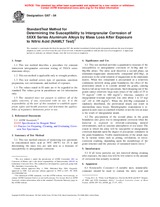We need your consent to use the individual data so that you can see information about your interests, among other things. Click "OK" to give your consent.
ASTM G67-04
Standard Test Method for Determining the Susceptibility to Intergranular Corrosion of 5XXX Series Aluminum Alloys by Mass Loss After Exposure to Nitric Acid (NAMLT Test) (Withdrawn 2013)
STANDARD published on 1.5.2004
The information about the standard:
Designation standards: ASTM G67-04
Note: WITHDRAWN
Publication date standards: 1.5.2004
SKU: NS-57779
The number of pages: 3
Approximate weight : 9 g (0.02 lbs)
Country: American technical standard
Category: Technical standards ASTM
Annotation of standard text ASTM G67-04 :
Keywords:
5xxx aluminum alloys, aluminum alloys, grain boundary sensitization, intercrystalline corrosion, intergranular corrosion, mass loss, nitric acid, pitting corrosion, ICS Number Code 77.040.30 (Chemical analysis of metals), 77.120.10 (Aluminium and aluminium alloys)
Additional information
| Significance and Use | ||||
|
This test method provides a quantitative measure of the susceptibility to intergranular corrosion of Al-Mg and Al-Mg-Mn alloys. The nitric acid dissolves a second phase, an aluminum-magnesium intermetallic compound (βAl-Mg), in preference to the solid solution of magnesium in the aluminum matrix. When this compound is precipitated in a relatively continuous network along grain boundaries, the effect of the preferential attack is to corrode around the grains, causing them to fall away from the specimens. Such dropping out of the grains causes relatively large mass losses of the order of 25 to 75 mg/cm2 (160 to 480 mg/in2), whereas, samples of intergranular-resistant materials lose only about 1 to 15 mg/cm2 (10 to 100 mg/in2). When the βAl-Mg compound is randomly distributed, the preferential attack can result in intermediate mass losses. Metallographic examination is required in such cases to establish whether or not the loss in mass is the result of intergranular attack. The precipitation of the second phase in the grain boundaries also gives rise to intergranular corrosion when the material is exposed to chloride-containing natural environments, such as seacoast atmospheres or sea water. The extent to which the alloy will be susceptible to intergranular corrosion depends upon the degree of precipitate continuity in the grain boundaries. Visible manifestations of the attack may be in various forms such as pitting, exfoliation, or stress-corrosion cracking, depending upon the morphology of the grain structure and the presence of sustained tensile stress.3 |
||||
| 1. Scope | ||||
|
1.1 This test method describes a procedure for constant immersion intergranular corrosion testing of 5XXX series aluminum alloys. 1.2 This test method is applicable only to wrought products. 1.3 This test method covers type of specimen, specimen preparation, test environment, and method of exposure. 1.4 The values stated in SI units are to be regarded as the standard. The values given in parentheses are for information only. This standard does not purport to address all of the safety concerns, if any, associated with its use. It is the responsibility of the user of this standard to establish appropriate safety and health practices and determine the applicability of regulatory limitations prior to use. |
||||
| 2. Referenced Documents | ||||
|
We recommend:
Technical standards updating
Do you want to make sure you use only the valid technical standards?
We can offer you a solution which will provide you a monthly overview concerning the updating of standards which you use.
Would you like to know more? Look at this page.




 Cookies
Cookies
